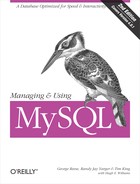The SQL Story
IBM invented SQL in the 1970s shortly after Dr. E. F. Codd invented the concept of a relational database. From the beginning, SQL was an easy-to-learn, yet powerful language. It resembles a natural language such as English, so it is less daunting to a nontechnical person. In the 1970s, even more than today, this advantage was important.
There were no casual hackers in the early 1970s. No one grew up learning BASIC or building web pages in HTML. The people programming computers were people who knew everything about how a computer worked. SQL was aimed at the army of nontechnical accountants and business and administrative staff who would benefit from being able to access the power of a relational database.
SQL was so popular with its target audience, in fact, that in the 1980s, Oracle Corporation launched the world’s first publicly available commercial SQL system. Oracle SQL was a huge hit and spawned an entire industry built around SQL. Sybase, Informix, Microsoft, and several other companies have since come forward with their implementations of SQL-based relational database management systems (RDBMSs).
When Oracle and its first competitors hit the scene, SQL was still relatively new and there was no standard. It was not until 1989 that the ANSI standards body issued the first public SQL standard. These days, the standard is referred to as SQL89. That new standard, unfortunately, did not go far enough into defining the technical structure of the language. Thus, even though the various commercial SQL languages were drawing closer together, differences in syntax still made it nontrivial to switch among implementations. It was not until 1992 that the ANSI SQL standard came into its own.
The 1992 standard is called both SQL92 and SQL2. The SQL2 standard expanded the language to accommodate as many of the proprietary extensions added by the commercial implementations as possible. Most cross-DBMS tools have standardized on SQL2 as the way in which they talk to relational databases. Due to the extensive nature of the SQL2 standard, however, relational databases that implement the full standard are very complex and resource intensive.
Tip
SQL2 is not the last word on the SQL standard. With the growing popularity of object-oriented database management systems (OODBMS) and object-relational database management systems (ORDBMS), there has been increasing pressure to capture support for object-oriented database access in the SQL standard. The recent SQL3 standard is the answer to this problem.
When MySQL came along, it took a new approach to the business of database server development. Instead of manufacturing another giant RDBMS and risk having nothing more to offer than the big guys, Monty created a small, fast implementation of the most commonly used SQL functionality. Over the years, that basic functionality has grown to support just about anything you might want to do with most database applications.
